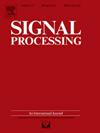Signed graph learning with hidden nodes
IF 3.4
2区 工程技术
Q2 ENGINEERING, ELECTRICAL & ELECTRONIC
引用次数: 0
Abstract
Signed graphs, which are characterized by both positive and negative edge weights, have recently attracted significant attention in the field of graph signal processing (GSP). Existing works on signed graph learning typically assume that all graph nodes are available. However, in some specific applications, only a subset of nodes can be observed while the remaining nodes stay hidden. To address this challenge, we propose a novel method for identifying signed graph that accounts for hidden nodes, termed signed graph learning with hidden nodes under column-sparsity regularization (SGL-HNCS). Our method is based on the assumption that graph signals are smooth over signed graphs, i.e., signal values of two nodes connected by positive (negative) edges are similar (dissimilar). Rooted in this prior assumption, the topology inference of a signed graph is formulated as a constrained optimization problem with column-sparsity regularization, where the goal is to reconstruct the signed graph Laplacian matrix without disregarding the influence of hidden nodes. We solve the constrained optimization problem using a tailored block coordinate descent (BCD) approach. Experimental results using synthetic data and real-world data demonstrate the efficiency of the proposed SGL-HNCS method.
求助全文
约1分钟内获得全文
求助全文
来源期刊

Signal Processing
工程技术-工程:电子与电气
CiteScore
9.20
自引率
9.10%
发文量
309
审稿时长
41 days
期刊介绍:
Signal Processing incorporates all aspects of the theory and practice of signal processing. It features original research work, tutorial and review articles, and accounts of practical developments. It is intended for a rapid dissemination of knowledge and experience to engineers and scientists working in the research, development or practical application of signal processing.
Subject areas covered by the journal include: Signal Theory; Stochastic Processes; Detection and Estimation; Spectral Analysis; Filtering; Signal Processing Systems; Software Developments; Image Processing; Pattern Recognition; Optical Signal Processing; Digital Signal Processing; Multi-dimensional Signal Processing; Communication Signal Processing; Biomedical Signal Processing; Geophysical and Astrophysical Signal Processing; Earth Resources Signal Processing; Acoustic and Vibration Signal Processing; Data Processing; Remote Sensing; Signal Processing Technology; Radar Signal Processing; Sonar Signal Processing; Industrial Applications; New Applications.
 求助内容:
求助内容: 应助结果提醒方式:
应助结果提醒方式:


